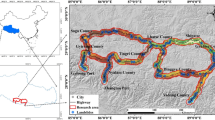Abstract
Estimation of rock mass deformation modulus is the subject of many studies in rock engineering research work. Although numerous predictive models have been developed for the estimation of the deformation modulus, they cannot be generalized for other sites because of inadequate accuracy. Furthermore, it is very valuable that the predictive models involve some accessible input parameters. The rock mass rating (RMR) is a well-known geomechanical parameter, which is usually determined to describe the quality of rock mass in rock engineering projects. In this study, five parameter ratings of the RMR classification system are used to predict the deformation modulus of rock mass in the abutment of the Gotvand earth dam. Statistical analysis and an artificial neural network are employed to present two new predictive models. Finally, probabilistic analysis is used to predict the rock mass deformation modulus, which overcomes the low accuracy caused by the inherent uncertainty in prediction. The results indicated that the parameter ratings used in the RMR classification system can predict the rock mass deformation modulus with a satisfactory correlation. However, the parameters don’t have the same influence on the rock mass deformability with the joint condition and the groundwater as the major and minor influencing parameters, respectively.










Similar content being viewed by others
References
Barton N (2002) Some new Q value correlations to assist in site characterisation and tunnel design. Int J Rock Mech Min Sci 39:185–216
Bieniawski ZT (1978) Determining rock mass deformability: experience from case histories. Int J Rock Mech Min Sci Geomech Abstr 15:237–247
Bieniawski ZT (1989) Engineering rock mass classifications. Wiley, New York
Evans E, Hastings N, Peacock B (1993) Statistical distributions, 2nd edn. Wiley, New York, p 170
Gokceoglu C, Sonmez H, Kayabasi A (2003) Predicting the deformation moduli of rock masses. Int J Rock Mech Min Sci 40:701–710
Gokceoglu C, Yesilnacar E, Sonmez H, Kayabasi A (2004) A neuro-fuzzy model for modulus of deformation of jointed rock masses. Comput Geotech 31:375–383
González Nicieza C, Álvarez Fernández MI, Menéndez Díaz A, Álvarez Vigil AE (2006) Modification of rock failure criteria considering the RMR caused by joints. Comput Geotechn 33(8):419–431
Hudson JA, Harrison JP (1997) Engineering rock mechanics, an introduction to the principles. Pergamon Press, Oxford, p 458
IWPCO (Iran water and power resources dev. Co.) (2005) Rock mechanics studies. Final report. Upper Gotvand dam and HPP
Kayabasi A, Gokceoglu C, Ercanoglu M (2003) Estimating the deformation modulus of rock masses: a comparative study. Int J Rock Mech Min Sci 40:55–63
Khademi Hamidi J, Shahriar K, Rezai B, Rostami J (2010) Performance prediction of hard rock TBM using rock mass rating (RMR) system. Tunn Undergr Space Technol 25(4):333–345
Kim CY, Bae GJ, Hong SW, Park CH (2001) Neural network based prediction of ground surface settlements due to tunneling. Comput Geotechn 28:517–547
Liu J, Elsworth D, Brady BH (1999) Linking stress-dependent effective porosity and hydraulic conductivity fields to RMR. Int J Rock Mech Min Sci 36(5):581–596
Malkawi AIH, Hassan FW, Abdulla FA (2000) Uncertainty and reliability analysis applied to slope stability. Struct Saf 22:161–187
Meulenkamp F, Alvarez Grima M (1999) Application of neural networks for the prediction of the unconfined compressive strength (UCS) from Equotip hardness. Int J Rock Mech Min Sci 36:29–39
Mitri HS, Edrissi R, Henning J (1994) Finite element modelling of cablebolted stopes in hard rock ground mines. In: Presented at the SME annual meeting. Albuquerque, pp 94–116
Monjezi M, Amiri H, Farrokhi A, Goshtasbi K (2010) Prediction of rock fragmentation due to blasting in Sarcheshmeh copper mine using artificial neural networks. Geotech Geol Eng 28:423–430
Nejati HR, Ahmadi M, Hasheomolhosseini H, Hayati M (2012) Probabilistic analysis of ground surface vibration due to train movement, a case study on Tehran metro line 4. Geotech Geol Eng 30:1137–1146
Nicholson GA, Bieniawski ZT (1990) A nonlinear deformation modulus based on rock mass classification. Int J Min Geol Eng 8:181–202
Palmstrom A, Singh R (2001) The deformation modulus of rock masses – comparisons between in situ tests and indirect estimates. Tunn Undergr Space Tech 16:115–131
Polson D, Curtis A (2010) Dynamics of uncertainty in geological interpretation. J Geol Soc Lond 167:5–10
Read SAL, Richards LR, Perrin ND (1999) Applicability of the Hoek-Brown failure criterion to New Zealand greywacke rocks. In: Proc 9th Int Cong on Rock Mechanics, Paris, pp 655–660
Rubinstein RY, Kroese DP (2007) Simulation and the Monte Carlo method. Wiley, New York
Rumelhart DE (1986) Learning representations by back-propagating errors. Nature 323:533–536
Serafim JL, Pereira JP (1983) Considerations on the geomechanical classification of Bieniawski. In: Proceedings of the symposium on engineering geology and underground openings. Lisboa, pp 1133–44
Singh VK, Singh D, Singh TN (2001) Prediction of strength properties of some schistose rocks from petrographic properties using artificial neural networks. Int J Rock Mech Min Sci 38:269–284
Singh TN, Sinha S, Singh VK (2007) Prediction of thermal conductivity of rock through physico-mechanical properties. Build Environ 42:146–155
Sonmez H, Gokceoglu C, Ulusay R (2004) Indirect determination of the modulus of deformation of rock masses based on the GSI system. Int J Rock Mech Min Sci 41(5):849–857
Sonmez H, Gokceoglu C, Nefeslioglu HA, Kayabasi A (2006) Estimation of rock modulus: for intact rocks with an artificial neural network and for rock masses with a new empirical equation. Int J Rock Mech Min Sci 43:224–235
Zhang L, Einstein H (2004) Using RQD to estimate the deformation modulus of rock masses. Int J Rock Mech Min Sci 41:337–341
Author information
Authors and Affiliations
Corresponding author
Rights and permissions
About this article
Cite this article
Nejati, H.R., Ghazvinian, A., Moosavi, S.A. et al. On the use of the RMR system for estimation of rock mass deformation modulus. Bull Eng Geol Environ 73, 531–540 (2014). https://doi.org/10.1007/s10064-013-0522-3
Received:
Accepted:
Published:
Issue Date:
DOI: https://doi.org/10.1007/s10064-013-0522-3




